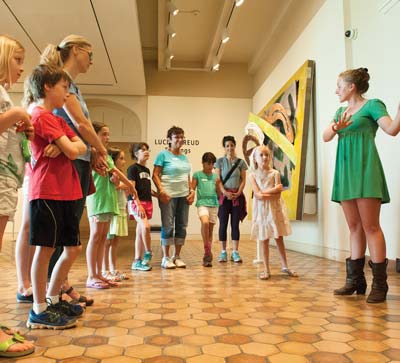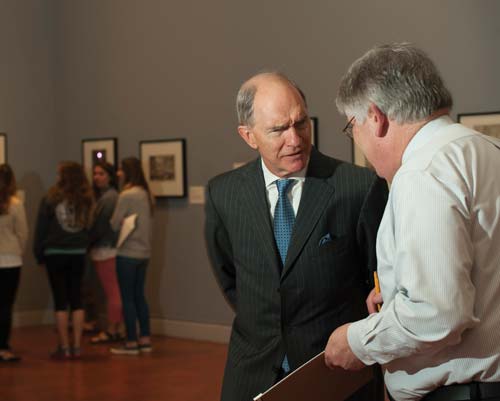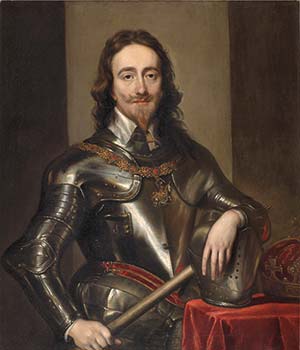More than a Museum
Fralin Museum’s collaborations aim for the heart and the mind
Study any painting or sculpture and you’ll find that understanding how the piece’s parts make a whole isn’t always easy to do. This is the challenge put to first-year medical students as part of Clinician’s Eye, a collaboration between the Fralin Museum of Art and the UVA School of Medicine that uses art to improve diagnostic skills.
“Observation, description, interpretation and communication of everything you’ve seen are really important skills for a physician,” says fourth-year medical student Grace Prince (Med ’15), who participated in the workshops. In one activity, a student will describe an object, and from that alone, another will try to draw it, leading to conversations about hearing and conveying information. “It’s important for patients,” says Prince. “In a lot of handoffs of care we have to be able to describe patients, what their illness is, what their treatment is.”

“My idea of a man sitting in a chair might be different from yours. If there’s a wineglass sitting in a room, what does your wineglass look like?” says Marcia Day Childress (Grad ’76, ’96), an associate professor of medical education who, along with the academic curator at the Fralin, Jordan Love, helped create the program, based on similar ones at Harvard and Yale. “Our goal is to school them in more mindful visual attention, how they describe, how they interpret,” says Childress. “There’s a tendency to go straight to, ‘I think I know what’s wrong,’ but that’s a matter of interpretation.”
Clinician’s Eye has been such a success that it’s now a required part of the medical school curriculum. For the Fralin, it’s a collaboration that represents the current spirit of the museum.
It hasn’t been a direct path to this point. The museum, which opened in the 1930s, took a hiatus during World War II, when much of the all-male student body went to fight overseas. When it reopened in 1946, it was used primarily for architecture exhibitions, and later ended up being converted into art and architecture classrooms. It was re-established as a museum in the early 1970s, when other buildings were created for those disciplines.

“We flew under the radar for a variety of reasons,” says Bruce Boucher, director of the museum since 2009. (In 2012, the then-University of Virginia Art Museum was renamed for Cynthia and Heywood Fralin.) “The upshot was that a lot of people weren’t aware of it, even people who were here in the ’70s and ’80s.”
Since those earlier decades, however, the museum, which holds nearly 13,000 objects, has been in the midst of a reawakening. Now, in its 80th year, it’s a hub of innovative outreach programs that harness its resources to enhance education and create meaningful connections with community members of all stripes. “We have this dual mandate of being a university museum, but also a museum of Central Virginia,” says Boucher. “We have strength in a number of fields, and this allows us to collaborate with a variety of departments in the College as well as other units and the community at large.”
The programs at the Fralin stimulate the brain—and open the heart.
Valerie Cole and her husband participate in Eyes on Art, a crossover program between the Fralin and the Alzheimer’s Association of Central and Western Virginia, where those in the early stages of the disease and their caregivers receive special tours and can engage with each other and the museum’s collections in a safe, welcoming atmosphere.
For Cole, it’s been a way to battle the loneliness that comes with caring for someone with the disease. “You don’t socialize a lot with other people when you’re involved with Alzheimer’s; you tend to stick with people who really understand. I’ve made some really good friends,” says Cole.
“Often this group of people gets isolated,” says Sharon Celsor-Hughes, creative arts director of the Arts Fusion program at the Alzheimer’s Association. “The contacts they’ve had are no longer comfortable with them. This program provides a great atmosphere that they can be at home in.”

Docents who are specially trained in how the disease progresses and are sensitive to the needs of the group give the tours. For instance, they give time to let participants process what they’re seeing, because they know that peripheral vision can be one of the first things to decline. “Part of the training is to present one thing at a time,” says Celsor-Hughes, “to not overwhelm anyone.”
“The goal is to get the people to talk about their reactions, to talk about anything that [the art] stimulates them to say,” says Aimee Hunt, the associate academic curator at the Fralin.
As part of the program, they’ve brought in a violinist and incorporated other music, which has been shown to be a mood enhancer. The tours have hands-on components, too. Because many participate as part of a couple, one such activity involves a participant drawing his or her partner.
Hunt recalls a man who had withdrawn into a nonverbal state drawing his wife. In doing so, he came out of his shell and started talking about how she’d once had very long red hair, and it was something he’d loved about her. “It was incredibly moving and sweet,” says Hunt. “It’s one of the most direct experiences I’ve ever had of a program serving its purpose.”
The beating heart of the museum, pumping vitality into all of its activities, is the docent program. Made up of volunteers from the community and students from the University, it’s one of the longest-running programs of its kind in the country.
Lauren Paullin, who coordinates the program, says that while many docents are art students, the program has diversified quite a bit over the years. “There are students from the Engineering School, the Batten School, and more, and they all bring an interest in art, and have a passion to share it with other people,” she says. Participants complete a 10-week training course, in which they learn about the museum’s collections and how to run tours.
“We deconstruct the notion of a museum as this inaccessible place that’s high-brow, only accessible to people who know the exact dates of the Renaissance,” says Emory Buck (Col ’15), who was an active docent for two years and served as chair of the program. “Docents can tell you those facts, but further we can put that into context and allow you to reach conclusions by yourself.”
That accessibility extends to all corners of the community, with the museum reaching out to young people, too. “Part of the concern of museums has to be the next generation of museumgoers,” says Boucher, “so starting people off when they’re young gets them in the habit.”
Buck, whose mother was an art historian, says the program is “a great way to talk about art and share the passion” she experienced as a child with other people, especially children.
Fralin program Early Visions, in partnership with the Boys and Girls Club of Central Virginia, pairs children ages 6 to 12 with UVA student mentors who help them engage with the museum through tours and creative activities. “We want them to be comfortable in a museum, get in-depth experience and build relationships,” says Catherine Jones, the program’s coordinator.
It’s beneficial for the mentors, too. “It helps them learn to relate to children and see them as little adults who have a lot to say and interesting thoughts,” Jones says. “It’s a good thing all around.”
Writer’s Eye, another program that appeals to young people, is a competition in which writers create works of prose or poetry based on the pieces from the museum’s collections. In 2014, the program received 1,690 entries that came from at least ten surrounding counties, and the winners were honored in a ceremony this spring.
With the success of its outreach programs, the Fralin naturally feels compelled to expand, to be able to do more. “At present, we are reaching the limits of programming because of space constraints,” says Boucher, who hopes to be able to expand within the next five years. “We have a beautiful design for a new wing behind the Bayly Building that will allow us to span the difference between where we are and where we want to be.”
Cavaliers Collect
“It struck me a couple of years ago that it seemed a good time to take stock of how far we’ve come,” says Bruce Boucher. With that in mind, and to celebrate the museum’s 80th anniversary, he’s curating Cavaliers Collect, an exhibition that starts August 28 and consists of loans from alumni with distinguished art collections that capture the spirit and interests of the UVA community. Here are Boucher's perspectives on a few pieces from the exhibition:

Oil on canvas, 42 x 35 in.
Courtesy of Neville and John H. Bryan (Darden '60)

Oil on canvas, 23 x 19 in.
Courtesy of Cynthia K. Fralin and W. Heywood Fralin Sr. (Col '62)

Bronze with silver inlay and precious stones
21 ⅝ x 14 ¼ x 8 ⅕ in.
Courtesy of a private collection

Oil on canvas, 78 ¾ x 78 ¾ in.
Courtesy of Thompson Dean III (Col '79)
